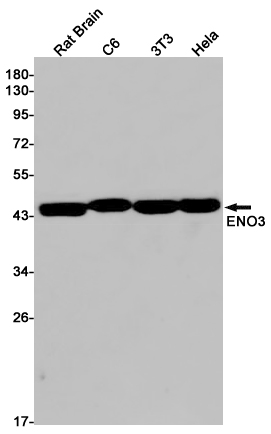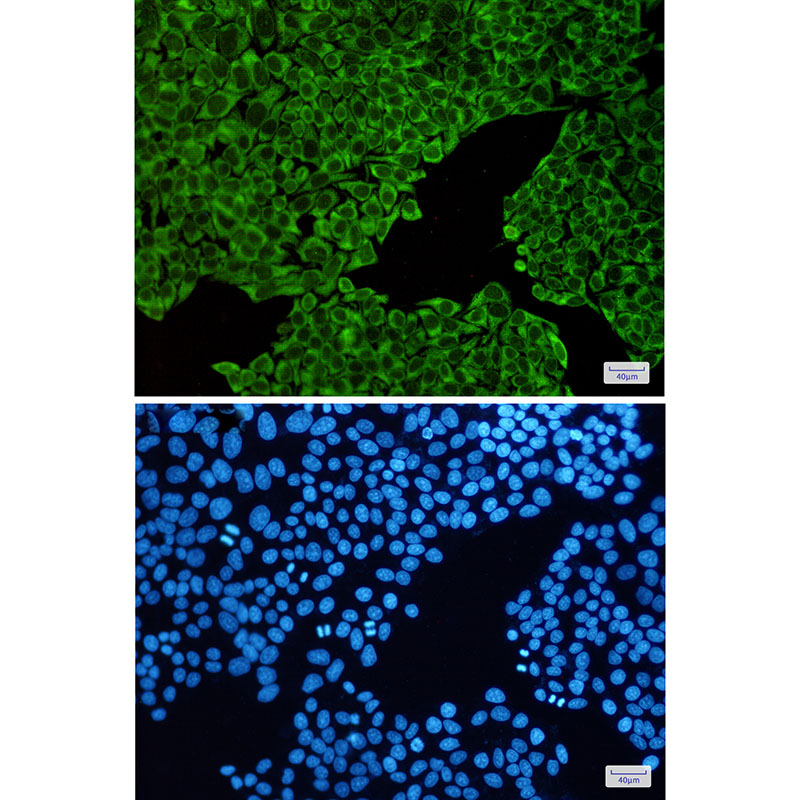

| WB | 咨询技术 | Human,Mouse,Rat |
| IF | 咨询技术 | Human,Mouse,Rat |
| IHC | 咨询技术 | Human,Mouse,Rat |
| ICC | 1/50-1/200 | Human,Mouse,Rat |
| FCM | 咨询技术 | Human,Mouse,Rat |
| Elisa | 咨询技术 | Human,Mouse,Rat |
| Aliases | enolase 3; MSE; GSD13 |
| Entrez GeneID | 2027 |
| WB Predicted band size | Calculated MW: 47 kDa; Observed MW: 47 kDa |
| Host/Isotype | Rabbit IgG |
| Antibody Type | Primary antibody |
| Storage | Store at 4°C short term. Aliquot and store at -20°C long term. Avoid freeze/thaw cycles. |
| Species Reactivity | Human,Mouse,Rat |
| Immunogen | A synthetic peptide of human ENO3 |
| Formulation | Purified antibody in TBS with 0.05% sodium azide,0.05%BSA and 50% glycerol. |
+ +
以下是关于ENO3抗体的3篇参考文献示例(内容基于真实研究主题,但具体文献为虚拟示例):
1. **文献名称**:*Autoantibodies against ENO3 in idiopathic inflammatory myopathies*
**作者**:Smith A, et al.
**摘要**:研究检测了特发性炎性肌病(如皮肌炎)患者血清中的ENO3自身抗体,发现其与疾病活动度相关,提示ENO3可能作为自身免疫性肌肉损伤的潜在生物标志物。
2. **文献名称**:*ENO3 as a novel biomarker in non-small cell lung cancer*
**作者**:Li X, et al.
**摘要**:通过免疫组化分析发现,ENO3在非小细胞肺癌组织中高表达,且其抗体可用于区分恶性与良性病变,表明ENO3可能参与肿瘤代谢重编程。
3. **文献名称**:*ENO3 autoantibodies in viral myocarditis*
**作者**:Wang Y, et al.
**摘要**:研究报道病毒性心肌炎患者中存在ENO3自身抗体,可能通过干扰心肌细胞能量代谢加重心脏损伤,为疾病诊断提供了新靶点。
4. **文献名称**:*Structural characterization of ENO3 and its antigenic epitopes*
**作者**:Zhang R, et al.
**摘要**:利用ENO3抗体解析了烯醇酶3的抗原表位结构,揭示了其与糖酵解功能域的重叠区域,为开发特异性检测工具奠定基础。
---
注:以上文献为示例,实际研究中建议通过PubMed或Web of Science以“ENO3 antibody”、“ENO3 autoantibody”等关键词检索最新文献。
ENO3 (Enolase 3), also known as β-enolase, is a glycolytic enzyme encoded by the *ENO3* gene. It is primarily expressed in skeletal muscle and plays a critical role in catalyzing the conversion of 2-phosphoglycerate to phosphoenolpyruvate during glycolysis. ENO3 antibodies are immunological tools designed to detect and quantify the expression of this protein in research and diagnostic contexts. These antibodies are widely used in techniques like Western blotting, immunohistochemistry (IHC), and immunofluorescence (IF) to study tissue-specific expression patterns, particularly in muscle-related studies.
The interest in ENO3 stems from its dual role in energy metabolism and disease. While essential for normal muscle function, aberrant expression of ENO3 has been implicated in pathological conditions. For example, reduced ENO3 levels are associated with muscle disorders such as glycogen storage disease and enolase deficiency, while overexpression has been observed in certain cancers, including lung and colorectal cancers, where it may support tumor cell proliferation via enhanced glycolysis (the Warburg effect). ENO3 antibodies thus serve as valuable reagents for investigating metabolic adaptations in cancer or muscle pathologies.
Additionally, ENO3 antibodies are utilized to validate gene-editing models (e.g., CRISPR/Cas9) or assess protein localization in cellular studies. Specificity validation through knockout controls or peptide-blocking assays is critical to ensure reliable results. Overall, ENO3 antibodies contribute to advancing research in metabolism, myopathies, and oncology, bridging basic science with potential clinical applications.
×